
ICON articles extracted from the mailing list
Tie wires and how they were used
Compiled by Bill Meier
4 March 2007
Brent Burger comments:
(Photos courtesy of Pat Scott)
This series of photos sure put me in good spirits, thinking back on funny things and times when we saw this stuff on a regular basis. The humor comes from a term we call "FTD". Basically, it means everyone else got an ice cream cone and you got a poke in the eye.
This photo sets the stage. Climbing a pole for that "jewel", this was the best a person like me could hope for. A loose, simple tie. Easy off, easy back on. You are up and down the pole in minimal time, minimal risk of getting caught by passersby or Johnny Law.
| Tie #20 - Railroad code line on Hemingray beehive |
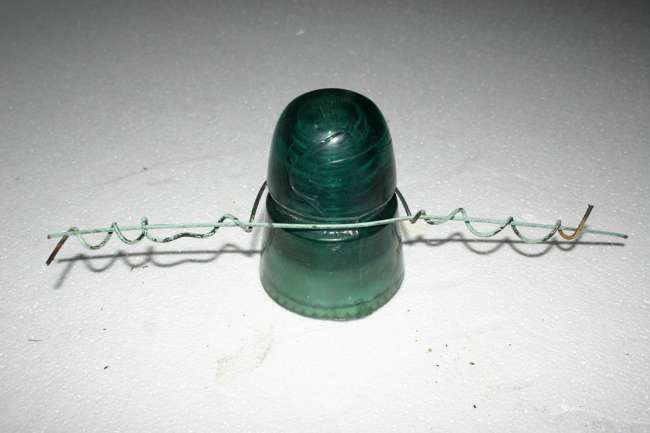 |
| Thin copperweld held on by copperweld tie. It appears this insulator was a replacement and the tie wire reused. |
This is also a simple tie, but given that it is iron wire and three feet thick made for a very rough go on our "rose petal" hands. It was stiff as stone and about half past impossible to tie back around a replacement piece. These were no fun at all.
| Tie #6 - Iron on a 42 |
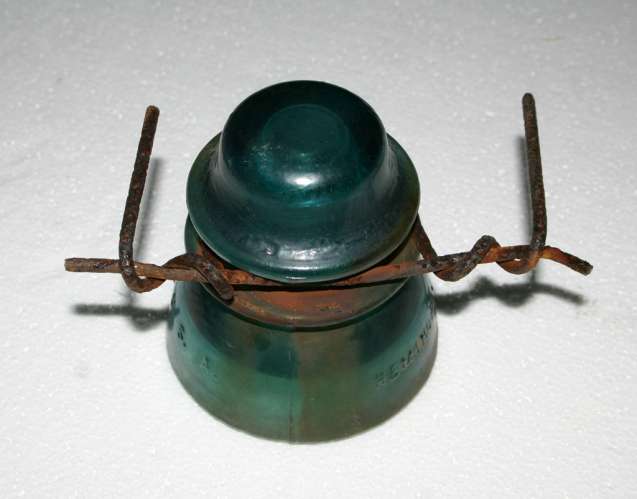 |
| Hemingray 42 with single iron conductor and tie wire, once around the neck. |
This one is just plain bizarre. What is the point ? Did the lineman think this thing was going to move ? I saw 1000's upon 1000's of these in service. I don't recall ever seeing one tied off. The line wire was simply wound through it and the tension taken up. Cool photo !
| Tie #10 - Case tramp bracket with wires |
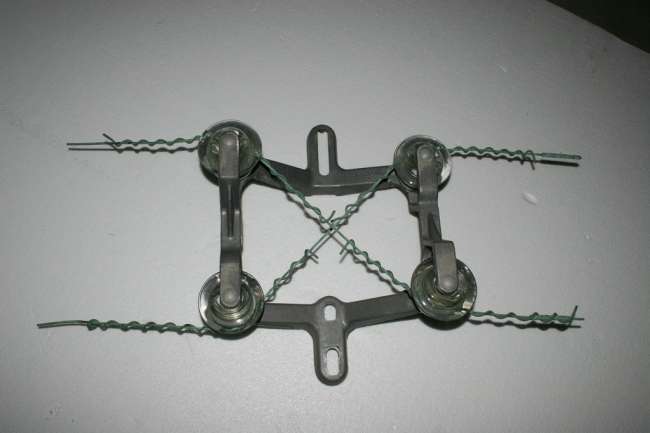 |
| Case transposition bracket with copper conductor and tie wires. Sometimes the conductors were not tied to the spools, rather, the line tension held them in place. |
Another dreamy find, ... especially with that old No.7 signal. I LOVE those things ! Soft tie wire, simple tie. Up and down the pole in under 60 seconds.
| Tie #11 - Old fire alarm telegraph wire |
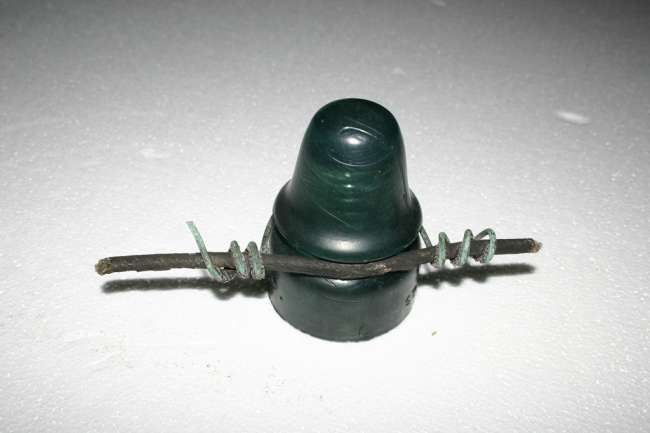 |
| HG No 7 Standard with insulated copper conductor and insulated copper tie wire, once around neck. |
Talk about a 4 foot cop with a five foot gun !
| Tie #12 - R-3 with railroad code line |
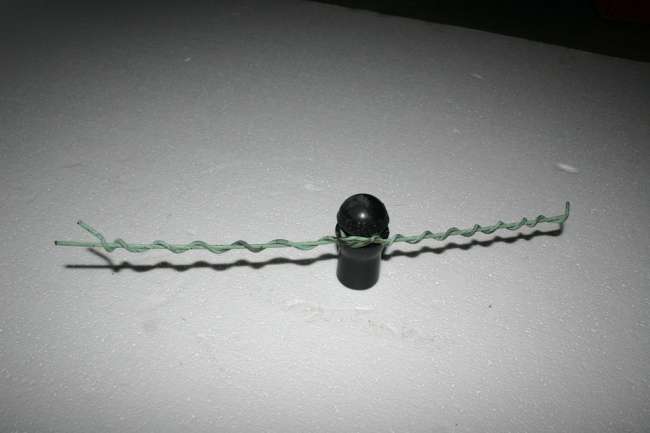 |
| Here is an R-3 with a copper conductor and copper tie, once around the neck, crossed over at the front on conductor, which is different from [id=177546218] where the tie does not cross over the conductor. |
This one has "farmer line" written all over it. Very unprofessional work here. A real pain to extract the glass and replace. Probably require a block and grips to keep it from getting away on you. This kind of thing would typically involve a desirable insulator on the pole right in the parking lot of a busy roadside restaurant and a guy who I can see from the poletop has taken an unrelated, yet very discomforting interest in my old truck or the contents of the back.
| Tie #15 - Farmer job? Hasty rig? Who knows. |
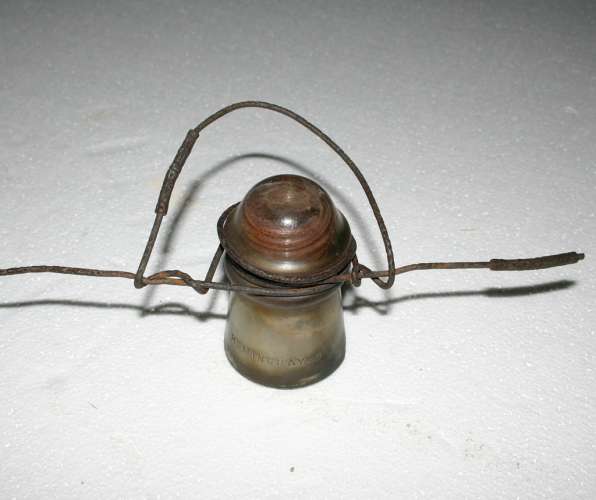 |
| This is two iron wires dead ended on a Hemingray 9, both double wrapped around insulator, then the ends spliced to form one conductor. |
A major pain in the ass. These were usually much more tightly wound than this one shows. Linemen often liked to use this "reverse loop" tie on 3-point spreader brackets for house drops. This usually fed straight off the transformer on one side, with the long drop and related pull to the other. With no tie to remove, the insulator had to be spun off the pin against all that friction of the reverse looped and cloth / tar covered wire, before you could then proceed to fight the one-sided pull of the drop as you tried to get impossible leverage to untwist the loop and get the insulator free. Putting the replacement glass back was not one bit easier. I recall a red amber Brookfield 162.1 that put me through this motion. It took a pretty special insulator to make this worth the trouble. Many good insulators were hopelessly left behind after attempting this the first time.
| Tie #19 - Dead end 2400 V on pintype |
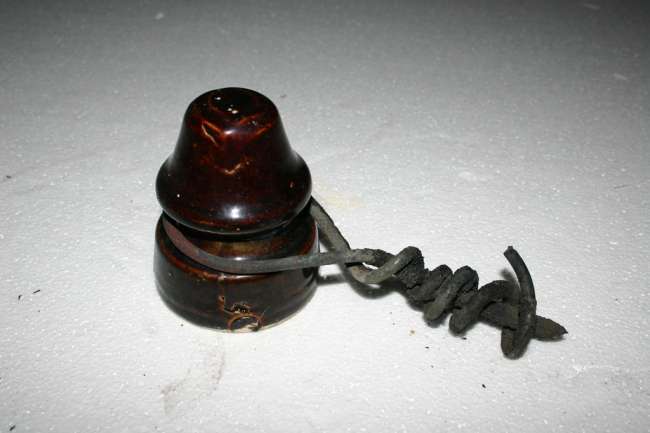 |
| Simple insulated copper conductor wrapped once around insulator and twisted on itself for a dead end. |
This one also looks to be a farmer line piece. That pigtail tie over the rest is bizarre. The original tie looks like a very good one and very sound. Someone REALLY did not want this one getting away.
| Tie #24 - Older telephone line on 1960 vintage Armstrong |
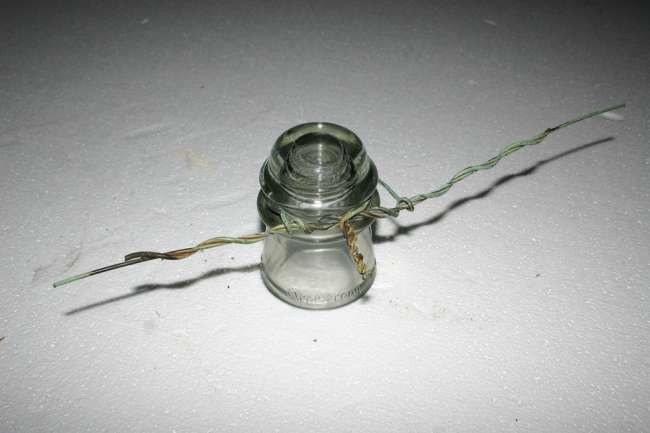 |
| This is a copperweld conductor with steel twist around wire. Tie wire is also copperweld and is wrapped twice around the groove, then twisted together rather than around conductor. This insulator is an obvious replacement, as the rest of the line was Hemingray 9s and the like. The tie wire was obviously untwisted then reused. This was found along a stretch of nine old side pin poles that ran from an interface with an underground phone cable. The line dead ended at a 90 degree pole, but unfortunately did not any longer continue past that pole. |
Man, were these a bugger. Not impossible, but always found where you wanted to be on the pole a minimum of time. To unravel the tie, you unwound the one end, then had to force the loosened slack through the looped over tie at the line wire (which was always tight). This was bad enough on single wraps, but on the doubles it required pulling a substantial length of that kinked-up wire through the tight spot to get the insulator free. I often took my own fresh tie wire up with me and cut this type off completely. If you look closely, you will see this tie would be far easier to remove from the right side than the left.
| Tie #33 - Copper on a porcelain signal |
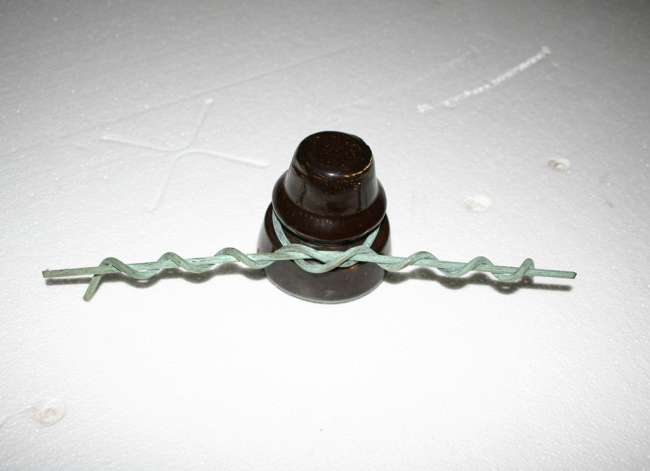 |
| Copper conductor with copper tie wire, twice around neck, and crossed twice over conductor. This was a railroad power line. |
Fortunately, this new "preformed" style was almost always found on modern glass. Made of a spring steel alloy, they were stiff and a real bugger to get off.
| Tie #38 - Telephone company tie job |
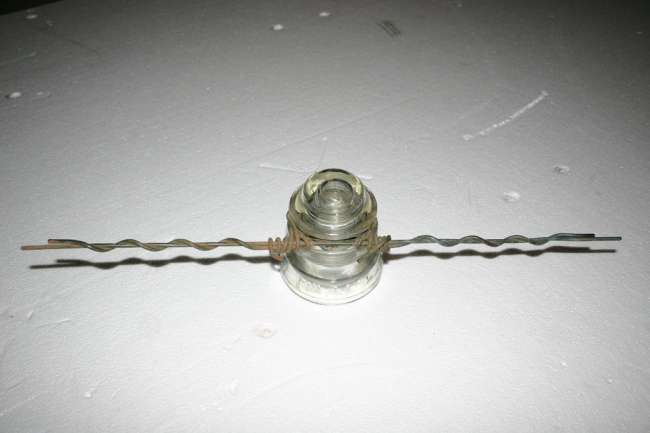 |
| Copperweld conductor with steel standoff wrap, tied with copper tie wire three times around neck. This came from a farm in southern Kansas. The farmer had these piled up after having taken a load of phone poles back in the 1970s from a phone company taking down nearby lines. |
This one looks a little tight, but Spiral Grooves worked just like the ads said they would, .... spin the insulator off the pin while pushing upward on the line and both came free. Trouble was, you'd have to replace one Spiral with another to complete the process.
| Tie #39 - Neat iron twist splice on CD 147 |
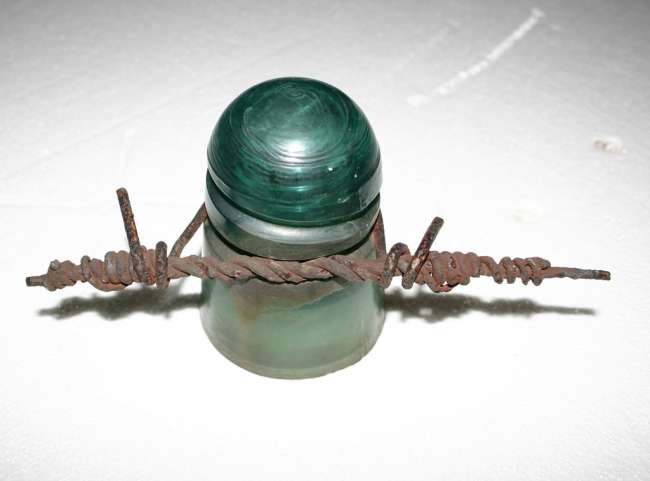 |
| Iron conductor tied with iron tie wire once around the neck. The interesting feature with this one is the twisted splice on the conductor right at the insulator. This is perhaps my favorite, and one of the few I want to keep, should you find yourself interested. This one came from Stanton, MO on the old Frisco, the line many people have commented on running along I-44 through southeast Missouri. The line was taken down in 2005. I was getting most of the glass anyway, but this one was a bit luckier find. The contractors had already sold the poles and moved them to a nearby property. I found the owner and asked about the insulators, where this one ended up being. He told us to take as many as we wanted, because he wanted to get rid of them all but did not know how he was going to do so. He only wanted the poles. |
Thank goodness there was no good reason to bother with this tightly wrapped overkill, ..... unless, of course, it was red and had a bolt through it.
| Tie #42 - Even a Porter can be interesting |
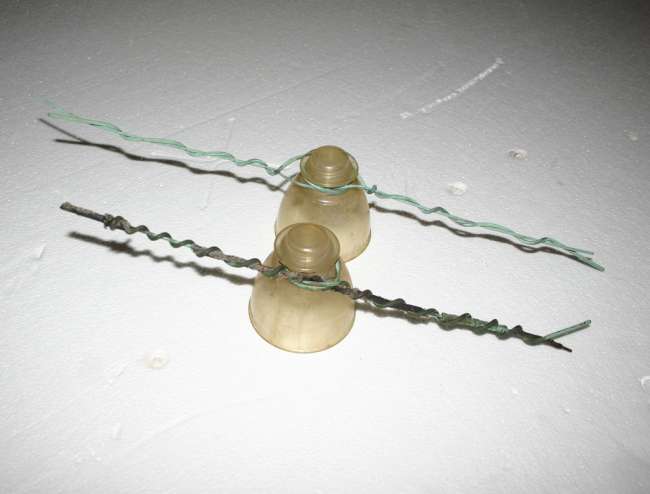 |
| Both of these show copperweld conductors with copperweld ties. The front one has the tie going once around the neck and crossing the conductor twice, the back going twice around the neck and crossing conductor once. |
Murphy's Law played well into the tie wire vs. insulator vs. exposure to getting caught equation. I was never a lineman, although I befriended many and learned a lot about how to retrieve insulators as expeditiously as possible. This was helpful on some accounts, but you were still open to getting tagged by Officer Badhassle and taken downtown. The best insulators were always in the worst locations, with the barking dogs, the children in the yard yelling "Mommy, ... what's that guy doing up there on the pole?", with the cop station or power / phone yard right across the street (or both! ). Naturally, the nastiest Houdini type tie wire was reserved for the pole in front of the gas pumps at the high traffic convenience store, and it was (of course) tied around the mustard Star 102 or sapphire NEGM beehive.
All part of the fun of picking in the wild. Thanks for the trip down memory lane, Pat.
El Picko del Risko
Bill Meier comments:
Here is a wonderful set of tie wire variations that Pat Scott posted. Just keep clicking "Next" to advance through them all.